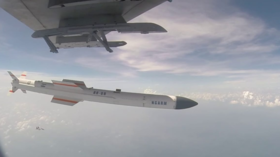India tests its first anti-radiation missile capable of 'neutralizing' enemy's air-defense setup – country's MoD

India's military has announced that it successfully tested its first indigenous anti-radiation missile intended for use by the Indian Air Force (IAF) in the latest series of military hardware trials.
The country test-fired its New Generation Anti-Radiation Missile 'Rudram' from a Sukhoi Su-30MKI fighter jet at an integrated test range near Balasore in the Bay of Bengal on Friday. Developed by the Defense Research and Development Organization (DRDO), the Rudram 1 radar-neutralizing missile was launched from a Russian-designed Sukhoi Su-30MKI fighter jet.
"With this, the country has established indigenous capability to develop long-range, air-launched, anti-radiation missiles for neutralizing enemy radars, communication sites and other radio frequency emitting targets," the DRDO said.
#WATCH: 'Rudram’ Anti-Radiation Missile fired from a Sukhoi-30 fighter aircraft off the east coast.The missile, developed by Defence Research and Development Organisation, was test-fired successfully today and is the country’s first indigenous Anti Radiation missile for IAF. pic.twitter.com/qVDT3gdqEN
— ANI (@ANI) October 9, 2020
Indian Defense Minister Rajnath Singh tweeted support for the DRDO, calling the test a "remarkable achievement."
The New Generation Anti-Radiation Missile (NGARM) is reportedly capable of hitting targets up to 250km away, depending on the launch height. The missile has a launch speed of up to Mach 2 and will be integrated with the IAF's sizeable fleet of Sukhoi Su-30MKIs. The missile is equipped with a passive homing head that can detect a wide range of frequencies.
The New Generation Anti-Radiation Missile (Rudram-1) which is India’s first indigenous anti-radiation missile developed by @DRDO_India for Indian Air Force was tested successfully today at ITR,Balasore. Congratulations to DRDO & other stakeholders for this remarkable achievement.
— Rajnath Singh (@rajnathsingh) October 9, 2020
A senior government official told the Hindustan Times that the successful tests represented a great step forward for India to enhance its defense capabilities.
The IAF will now have the capability to perform SEAD (Suppression of Enemy Air Defense) operations deep in enemy territory to destroy adversaries' air-defense setups
Friday's trial comes just days after the DRDO carried out another major test of a Supersonic Missile Assisted Release of Torpedo (SMART) system. Earlier this month, India tested the 700km range surface-to-surface supersonic 'Shaurya' strategic missile, while in September it tested an indigenously-developed hypersonic technology demonstration vehicle (HSTDV) and test-fired a Laser-Guided Anti-Tank Guided Missile (ATGM).
Meanwhile, the soon-to-be tested 'Nirbhay' missile has reportedly been deployed in northern India in response to Chinese build-up in the region.
Also on rt.com India hails ‘major technology breakthrough’ after successful testing of supersonic missile assisted release of torpedoIndia has been stepping up military trials of indigenous-built hardware as part of an attempt to achieve self-reliance in defense tech and demonstrate its capabilities amid heightened border tensions with China. Earlier this year, troops from the two nations clashed in Eastern Ladakh, along the de facto border known as the Line of Actual Control (LAC).
Like this story? Share it with a friend!













